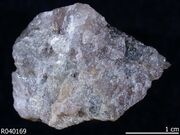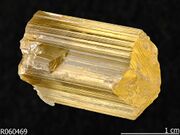Scapolite
Jump to navigation
Jump to search
Description
Any of several fluorescent silicates used as gemstones. Scapolites are transparent to translucent stones that occur in pastel shades of yellow, pink, lavender, purple, and cat's eye. Two types of scapolites are: marialite (sodium aluminosilicate), and meionite (calcium aluminosilicate). Scapolites are mined in Myanmar (formerly Burma), East Africa, Sweden (Kiruna), Australia (Queensland), Canada (Quebec, Ontario-yellow), the U.S. (New York, New Jersey, Pennsylvania) and Mexico (Oaxaca-white).
Synonyms and Related Terms
wernerite (former group name); marialite; meionite; sodalite; dipyre (now used for the marialite-rich variety); mizzonite (now used for the meionite-rich variety); escapolite (Port.)
Physical and Chemical Properties
- Short, square prismatic crystals
- Cleavage is distinct in two directions
- Fracture = conchoidal to uneven
- Streak = white
- Luster = vitreous
- Fluorescence = strong pink, yellow or orange
- Pleochroism = moderate to strong blue in pink, purple and violet stones
| Mohs Hardness | 5.0 - 6.0 |
|---|---|
| Density | 2.3-2.8 g/ml |
| Refractive Index | 1.483 - 1.600 |
| Birefringence | 0.005 - 0.038 (increases as RI increases) |
Resources and Citations
- Gem Identification Lab Manual, Gemological Institute of America, 2016.
- Mineralogy Database: Scapolite
- Wikipedia: Scapolite



